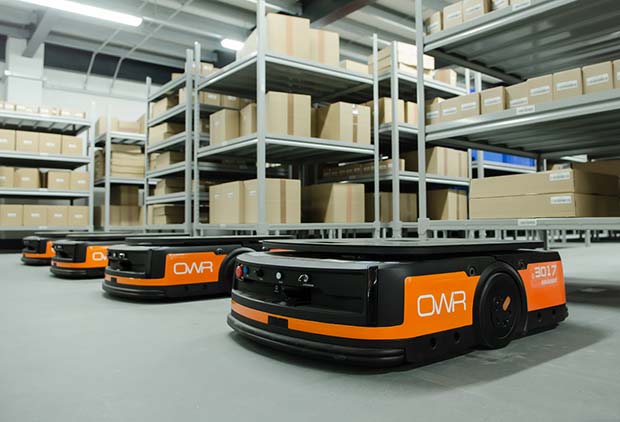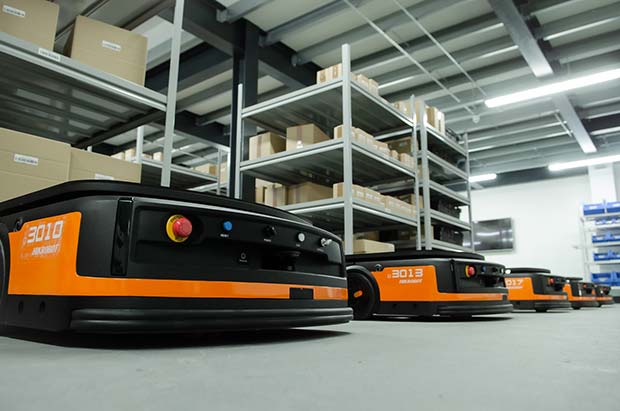You’ve probably heard of catchphrases such as ‘the robotics revolution’ and ‘Industry 4.0’, and that’s with good reason. These are the here and now in the world of automation and will completely upend and revolutionise the warehouse and distribution sector as we know it.
 Automation is no longer reserved for the mega-corporations like Amazon and Ocado. Operations all over the UK are jumping on board and realising its potential to enhance their processes.
Automation is no longer reserved for the mega-corporations like Amazon and Ocado. Operations all over the UK are jumping on board and realising its potential to enhance their processes.
As flexible robotics becomes more widely adopted, the impact of Industry 4.0 will be felt throughout the market. For your business, that feeling will either come in the form of enhanced productivity or difficult competition against those that have already adopted warehouse automation.
But, what does all this mean? What is Industry 4.0 and how can a robot be ‘flexible’? When you find out the answers, you’ll know why this is a train you need to get aboard sooner rather than later…
What is Industry 4.0?
Originally coined in Germany, the term Industry 4.0 refers to the idea that we are currently living through the fourth wave of the industrial revolution. Industry 1.0 was powered by steam, Industry 2.0 was powered by electricity and Industry 3.0 was powered by computers.
Industry 4.0 is something very different. All the other waves were based on better ways to work by using better technology. In Industry 4.0, technology is finding better ways to work with itself.
Technology from Industry 4.0 has four marked characteristics:
Self-monitoring – Technology that can sense its environment and follow its own position and progress
Self-configuration – Technology that can use information gathered by sensors to direct its own operations
Self-optimising – Technology that can select a configuration that will make things faster, more economical, and more efficient
Self-diagnosing – Technology that can detect, identify, and resolve any of its own internal problems
Industry 4.0 has emerged from the confluence of a wide range of technologies. From machine vision cameras and more advanced data processing algorithms to SLAM navigation and wireless internet connectivity. All of this has come together to create flexible robotics – the next step in the world of warehouse automation.
What is flexible automation?
To understand flexible automation, we first need to contrast it against the older fixed options.
Fixed automation is so-called because it uses fixed systems to move and sort products. Conveyor belts are built in place, robotic arms are bolted to the floor and storage units are in fixed ranks and files. They can’t be moved or changed without breaking out toolboxes and scheduling weeks of inactivity in the warehouse, making it inconvenient for most operations to switch-up their robotics.
Flexible automation uses systems that can move and adapt. Robots are not fixed in place; rather they roll freely around the warehouse floor. Using data matrix codes stuck to the floor for navigation, they pick up freestanding storage modules and move them to where they are needed.
The levels of efficiency offered by flexible automation when compared to fixed systems or manual operation is nothing short of revolutionary.
 Efficient time management
Efficient time management
Imagine an employment situation where you hire someone whom you know will not be providing your business with substantive value for more than half the time they’re on the clock. Unfortunately, this is a reality for most warehouse environments. However, it’s not because warehouse pickers are lazy. It’s because they spend 50-70% of their time walking between bins.
Flexible automation allows businesses to recoup that lost time. With robots able to bring items to operatives using a goods-to-person solution, pickers can spend their time picking items from one place, creating a much more efficient operation.
Picking accuracy
To err is human, but mistakes and the subsequent returns they cause can be very expensive. More and more consumers are expecting to be able to return products for free, meaning mistakes become harder to afford for businesses. In manual warehouses, time spent picking with surrounding distractions can cause mistakes to happen more frequently. Estimates range between 0.3% and 3%, but even that can be troubling for medium and larger businesses.
By eliminating the walking time, flexible automation provides a much higher level of accuracy. Combining the freely moving robots with equipment like pick lights, your workers have the best possible systems to ensure that the right products go to the right place. In all, flexible automation offers your warehouse unbeatable levels of precision.
Fast installation
Many businesses have avoided automating their warehouses in the past because of the amount of time it takes. It can take weeks or even months to build functional conveyors, assemble robotic arms, or install gantry rails equipped with carrying apparatus. For many businesses, especially in this current climate, this is time they can’t afford to lose.
Flexible automation makes installation much simpler. With the robots already pre-built and pre-programmed, installation revolves around synchronising software and sticking DM codes in the correct places on the warehouse floor. These processes can be completed in a matter of days, reducing the amount of downtime needed substantially.
Grow with limited costs
When a warehouse employs a fixed automation system, it will struggle to grow beyond a certain point. Expanding the storage capacity of fixed systems is difficult to the point of near impossibility. It would essentially mean building an entirely new warehouse, turning expansion plans into expensive plans.
However, flexible automation changes all of that. It allows you to grow and change the shape of your warehouse with minimal intervention. Deploy new DM codes, set up more shelving racks, purchase more robots and you are ready to go. Your business will respond to your successes and your ambitions can continue being realised without breaking the bank.
Create more space
When you remove the need for warehouse operatives to be walking between storage bins, you remove the need for the walkway, too. Large quantities of warehouse floorspace that were previously dedicated to allowing staff to move freely can suddenly find themselves reutilised.
Warehouses making use of flexible automation could find their storage density abilities improved by up to 30%. This extra space can prevent businesses from needing to upgrade to a larger warehouse, making it well worth your while if you’re having capacity issues.
Respond to demand
Fixed automation means your storage plans and product organisation are also fixed. Regardless of how popular or how in demand certain ranges and fashions become, these products are fixed to a certain space in the warehouse and can’t be easily moved to accommodate demand. While your purchasing systems may gather a great deal of useful data about what your customers want fastest, a warehouse with fixed infrastructure can take too long to reorganise in response to such insights.
Flexible automation is not only easier to manage, but it can also do the calculations for you. With advanced KPI processing algorithms and intelligent software connections, flexible robotics can rearrange your warehouse on the fly, making sure the most in-demand products are in the right place for when you need them most.
Added-value roles
With the implementation of flexible automation comes the opportunity for a dramatic shift in the roles of workers in the warehouse space. The expectation that pool sizes of warehouse staff will change is just the tip of the iceberg.
Operatives who were previously confined to repetitive roles will discover that their value lies in their versatility. Pickers will become more involved in everything from equipment upkeep, to returns arrangements, to health and safety work and much more. The kinds of gains you will find from cross-connection across departments are truly worthwhile, for both your business and your employees.
Join the revolution!
The same pressures that are leading Amazon and Ocado towards flexible automation are sending more UK businesses in this direction, too. When considering the advantages that flexible automation offers, ask yourself, “Do I want to be competing against this, or using it to compete?” From this question, you will have probably found your answer.
To learn more, visit our Automation 101 resource centre. To look at our range of solutions, visit www.owrobotics.co.uk.
OW ROBOTICS
01522 704083





Comments are closed.